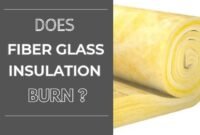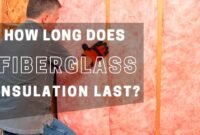Wall cavity insulation, also known as blown-in insulation, is a method of providing insulation to the space beneath your walls, either internally or externally.
Before discussing blown-in fiberglass insulation problems, you should know that there are two major types: cellulose and fiberglass. Blown-in insulation is injected into walls through small openings and is useful for improving heat transfer or minimizing noise entering or exiting the property.
In fact, it requires professional skills to set up and cannot be done as a do-it-yourself project. Nonetheless, it is quite simple yet not tough or bothersome.

The material’s structure is fluffy and light, so it rests with lots of air pockets everywhere throughout each piece. As a result, there are several areas where heating can become trapped, slowing the pace at which such heat departs the property, or cold penetrates from outside.
Blown-in Wall Insulation Problems
There are 3 major blown-in fiberglass insulation problems. Below are the wraps of them.
- Damp Problems That Are Difficult to Repair
Blown-in insulation can generate major and difficult-to-resolve damp concerns when applied to the outside walls of properties in which it is not appropriate. It is due to substances within the walls getting moist as rain intrusion can no longer be diverted away.
- Taking More Expenses
This is one of the problems with blown-in fiberglass insulation: damp insulation not only loses its effectiveness but also condenses, causing wet spots and mildew in your home. The only method to solve the problem is to eliminate all damp insulation, which can be expensive and may require the replacement of larger parts of brick or gypsum.
- More Prone to Settling
Walls’ blown insulation can cause problems due to their vertical aspect, which makes them much more vulnerable to settling. Whenever the wall is completely wrapped, it is doubtful that any gaps will form as a result of a material settling inside the hollow. However, it will perform inadequately.
Blown-In Insulation Health Risks
All types of blown-in insulation pose a health risk, especially fiberglass insulation. So, before you install it, perhaps you should be aware of the risks below.
- Skin Irritation
Whenever your bare skin comes into contact with fiberglass, the small glass shards inside the fiber can easily cut your flesh. These wounds can cause a lot of discomfort and irritation.
Though you may assume you have a skin rash following handling fiberglass, those marks are most likely wounds.
- Eye Irritation
This not only causes common blown-in fiberglass insulation problems but can also cause eye irritation. So, whenever you come into contact with fiberglass, your eyes will most certainly get red, inflamed, and swollen.
- Breathing Problems
Fiberglass fibers are easily inhaled. Once inside your body, the microscopic glass threads may puncture and pierce your tissues and organs. The following are some frequent indicators that you have inhaled fiberglass:
- Throat pain or irritation
- Discomfort in the nasal passageways
- Sore, irritated lungs
- Breathing difficulties
If you have a respiratory ailment such as bronchitis or asthma, exposure to fiberglass might aggravate your symptoms. Whether you have weakened or sensitive airways, it might possibly cause a respiratory problem. Finally, consuming fiberglass particles might result in significant stomach pain and inflammation.
- Cancer Risks
Fiberglass is a known carcinogen. Though some research has found an elevated cancer risk in mice once lung tissue is exposed to fiberglass, the jury is still out on the disease risk in people. Any contractor you speak with can inform you that the procedure is to keep direct interaction to a minimum.
However, worries about fiberglass should not be confused with the proven relationship between asbestos and lung cancer. These are two distinct materials.
Once placed on your property, fiberglass is not regarded as harmful in a passive sense. The health risks connected with fiberglass are only important when there is direct contact or exposure.
Thus, blown-in fiberglass insulation can have some problems, including health risks. This means that before installing it on your property, you must be careful and prepare for all the necessities to prevent those problems and risks.
Pros and Cons of Blown-In Fiberglass Insulation
| Pros | Cons |
|---|---|
| Lower cost compared to spray foam | Difficult to repair damp problems |
| Can be installed DIY | Health risks from skin contact and inhalation |
| Better performance than batt insulation | Settles over time, requiring maintenance |
| Fills gaps and contours to unique spaces | Less effective than other insulations like cellulose or spray foam |
| Moisture-resistant and reduces energy costs | Limited to attic applications |
Personal Experience
I have personally experienced these issues when dealing with blown-in fiberglass insulation in my own home. While the installation process initially appeared straightforward, it revealed significant challenges.
Read also: How to Remove Insulation From Attic
For instance, I had to remove damp insulation due to water intrusion, which was both costly and labor-intensive. Additionally, the health risks became evident when I noticed skin irritation and respiratory discomfort after handling the material without proper protective gear.


